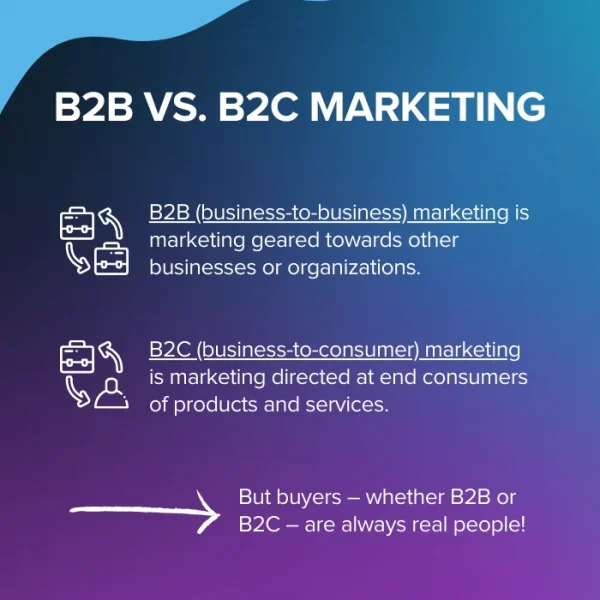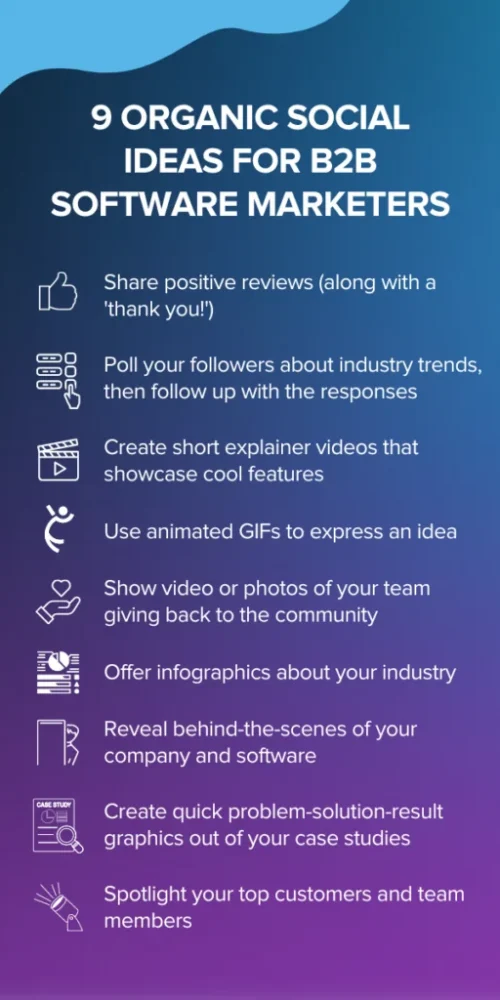Note: This blog was updated October 2024.
Buyers have needs – and now more than ever, they have many options to meet those needs. How do you stand out from this fierce competition? Take a look at these four important B2B software marketing tactics.

What Is B2B Software Marketing?
Before we get into these fundamental B2B software marketing methods, however, let’s define what we’re talking about. What is B2B software marketing – and how is it different from other types of marketing?
First: a quick refresh on B2B vs. B2C.

This means a business (your audience) is seeking to buy a software solution (you) that solves a business problem. More specifically, your solution solves a problem that an individual or team at another business faces.
Think, Salesforce to solve customer relationship management challenges. Or in the life sciences industry, an electronic trial master file (eTMF) to help improve the setup, collection, storage, tracking and archival of essential clinical trial documents.
With that in mind: What makes B2B software marketing special?
To answer this, let’s take a quick look at the buyer’s point of view:
Buying software as a business is an entirely different animal from buying, say, a piece of machinery. This is because software as a product (or technically these days, software-as-a-service (SaaS), considering very few software solutions are licensed and delivered in any other way) has a bunch of different characteristics. When you buy a machine for manufacturing purposes, you get and use it physically. With software, you’re getting:
- A free trial
- Pricing tier options with different features included in each
- An annual or monthly subscription
- User credentials for a website or application login
These factors alone make the process of buying and deploying B2B software much different than a physical machine – and thus, the act of selling works a bit differently, too. In fact, software can be a more difficult sell. A machine you can see and touch and justify pretty quickly, especially if it’s replacing something broken or outdated. Software can be invisible, depending on who’s using it.
The more niche your solution, the harder it is to convince people they need it. Plus, nobody likes change. On the flip side, the broader your solution, the harder it is to beat your competition.
Gah!
So, what is B2B software marketing? It can be a real challenge – but with these four fundamental tactics at your helm, you’ll be able to raise your brand awareness, cut through the noise, and meet your target audience’s needs.
4 Fundamental Tactics for B2B Software Marketing
#1. Share Helpful Educational Content
Here’s a mistake we see quite a bit: Gearing 100% of your web content to what makes your software awesome.
Don’t misunderstand us. You want some of your content – especially the main pages of your website – to explain what your product is, who it helps, and why it outshines the competition.
To successfully woo today’s customer, however, you’ll want to offer a lot more than that.
Think of this wooing process like moving up the ladder at work. If you only told people about your good qualities, you’d come off as self absorbed, right? Eventually your boss would get sick of hearing from you, thinking, “Geez, this person only ever talks about themselves!”
On the other hand, if you become the most helpful person at work – a go-to colleague who solves everyone’s problems (and especially the boss’s problems) – you’d become indispensable.
It’s the same with your blog posts, whitepapers, videos, and social posts. A good chunk of them, perhaps even the majority of them, should solve a problem your buyer might be facing. The theme of your B2B software marketing should be helpful, not self-promotional.
Consider how we do it at Altitude. Very few of our articles talk about our agency – and none of them provide a hard sell. Instead, the vast majority of them offer helpful information, within our area of expertise. We use the content to build awareness and trust. Then we ensure our “contact us” button is super easy to find should someone decide they want even more of our expertise.
#2. Think of Email as a Conversation
According to about 75% of B2B marketers, email newsletters are the top content distribution method after their website and blog.
Why? Because, when done right, they get results.
Every time you send an email, you put your software at the front of your buyer’s mind. That said, there’s an art to email marketing. Just like point #1, too many sales-focused emails and your buyer will likely tune out, opt out, or mark your emails as spam.
Going back to our B2B vs. B2C chart from earlier… it’s key to remember that, no matter what, you’re always selling to a real person. Not an enigma of a business. So, talk to your buyers like they are real people – because they are.
This conversational style can flow through all of your B2B software marketing emails:
-
- The subject line – why should the email recipient open your email?
-
- Your intro email text – how is the content of your email going to help the reader?
-
- Interactive elements, like a poll or video – how are you including the potential buyer in the conversation?
(Related: 10 Digital Marketing Trends for 2024)
Tactic | Impact | Implementation |
Share Helpful Educational Content | Builds trust and awareness by positioning your company as an expert resource before pushing sales messages. | Create blog posts, whitepapers, videos, and social media content that solves problems and provides valuable information related to your industry/solution, not just self-promotion. |
Think of Email as a Conversation | Nurtures interest and keeps your software top-of-mind by engaging recipients with a friendly, human approach. | Use conversational language, share helpful content, and mix in occasional promotional emails. Craft subject lines to encourage opens and include interactive elements. |
Use the 80-20 Rule for Organic Social | Maintains an engaged audience on platforms like LinkedIn by providing a balanced content mix. | Post 80% educational/entertaining content and only 20% promotional content about your software brand. |
Reach Niche Audiences with Digital Advertising | Expands reach by getting your messaging in front of two key groups: people actively searching for solutions like yours, and your ideal prospective customers. | Use Google search ads for behavioral targeting and paid social ads on platforms like LinkedIn for demographic targeting based on detailed buyer personas. |
FAQs
1. Why is digital advertising important?
Paid advertising allows you to get your messages in front of two key audiences: people actively searching for solutions like yours through search ads, and your ideal prospective customers through targeted social media ads. Combining both approaches maximizes your outreach.
2. Why is educational content important for marketing software?
Simply talking about how great your software is won’t be enough to convince buyers. Sharing truly helpful information through blog posts, videos, guides etc. allows you to build trust and awareness before pushing a sales pitch. Educational content positions you as an expert they’d want to work with.
3. What to do when a product is niche-specific? How to reach those specific buyers?
This is where targeted digital advertising helps, You can use platforms like LinkedIn to serve ads only to people who meet the detailed criteria and professional traits defining your ideal buyer personas. This precision targeting ensures your niche messaging hits the right audiences.
The main idea is to avoid being overly self-promotional in your marketing. Provide frequent educational content, have real conversations through channels like email and social media, and use paid advertising to expand your reach, but do so by first focusing on your audience’s needs and building value, not just selling.
Conclusion: To Reach Today’s Software Buyers, You Need Today’s Tactics
Though it’s becoming increasingly more challenging to sell to and retain software customers, these four fundamental marketing tools can increase your chances of success. The common thread? Understand that B2B software marketing requires a bit more education – communicated in a conversational, helpful manner.
(Related: The Top 6 Email Marketing Trends for 2024)




